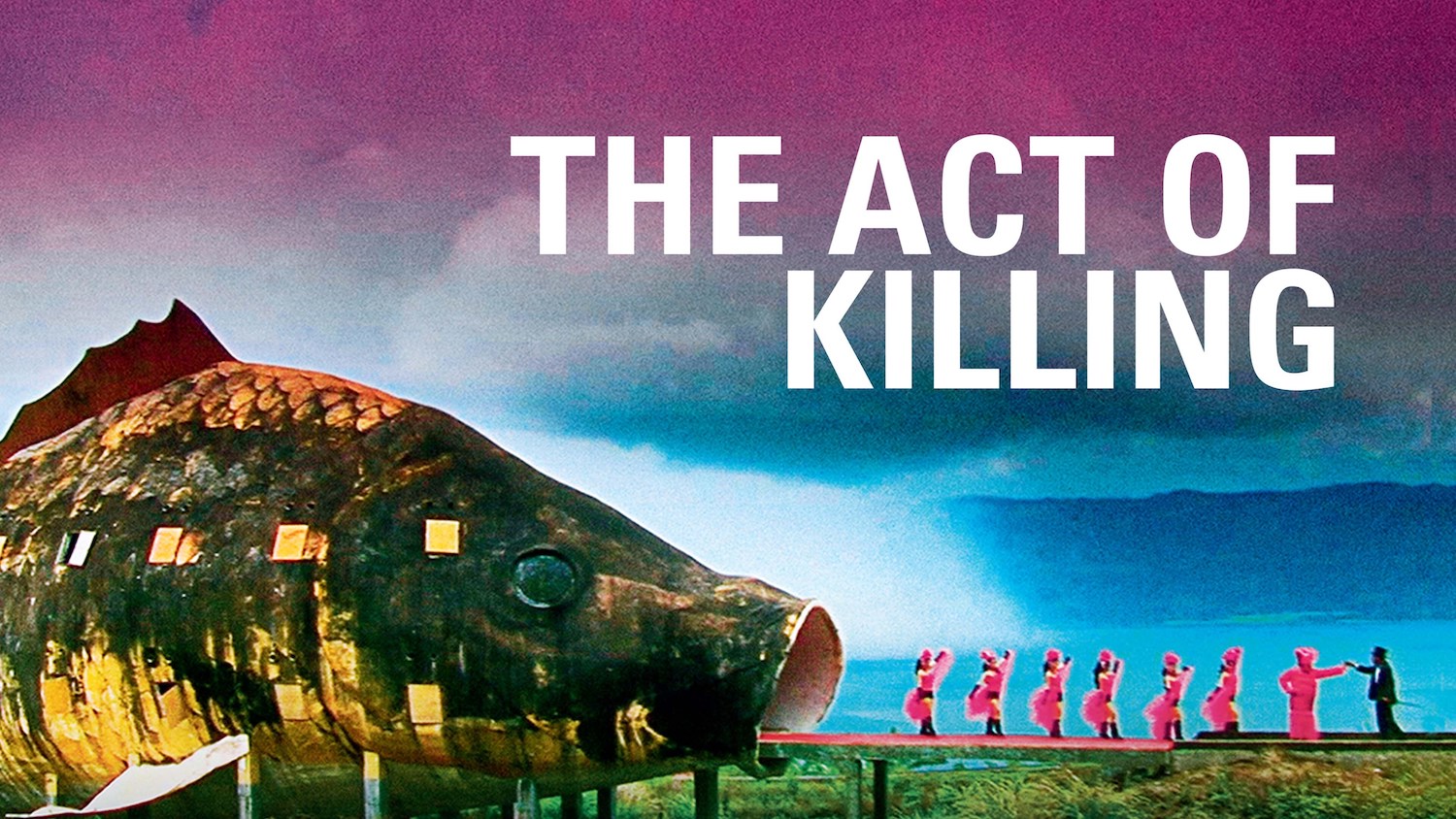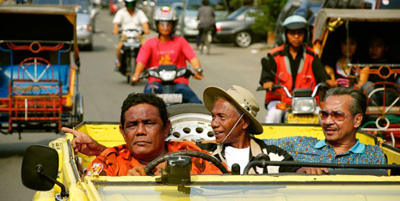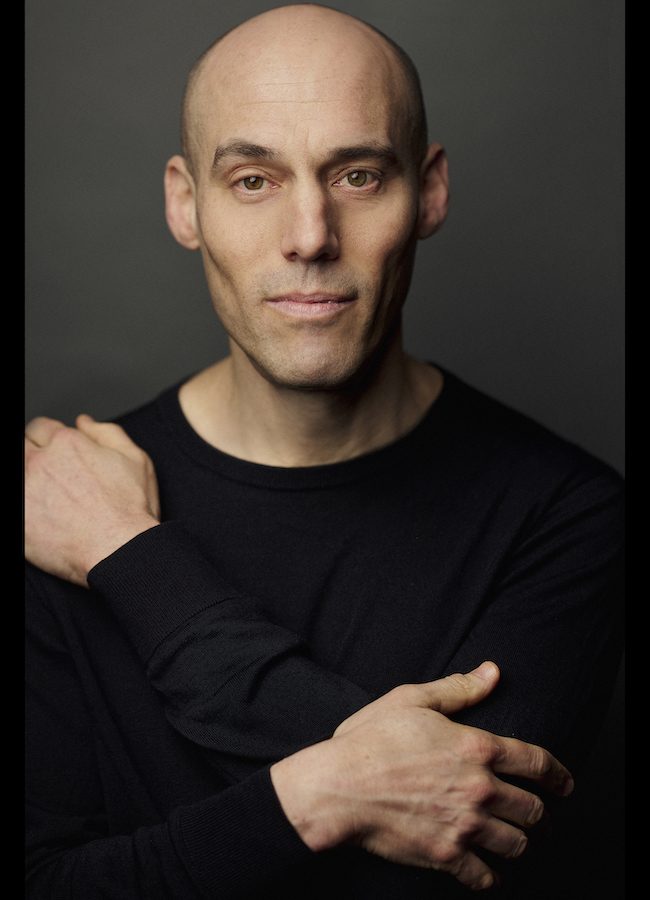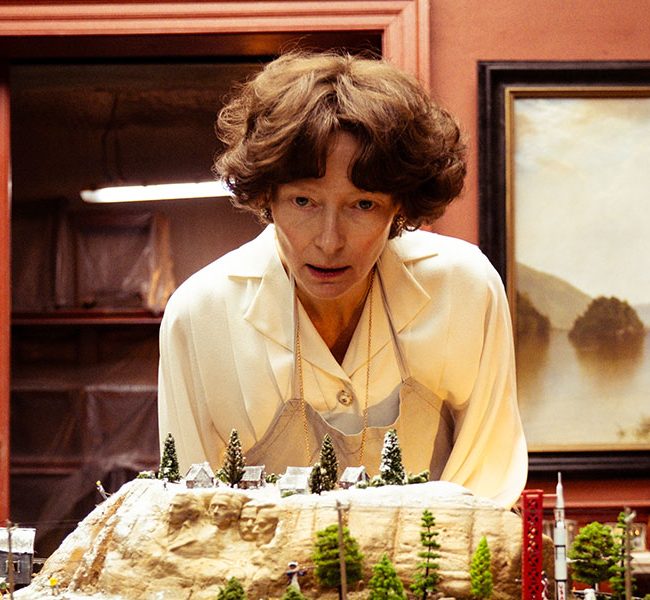ACT OF KILLING, THE

(The Act of Killing is now available on DVD + Digital Copy, Blu-ray + Digital Copy, Amazon Instant, iTunes (Theatrical Cut), iTunes (Director’s Cut) through New Video Group. It was picked up for domestic distribution by Drafthouse Films and opened theatrically on Friday, July 19, 2013. It first screened at the 2012 Telluride Film Festival, followed by the Toronto International Film Festival. Visit the film’s official website to learn more. NOTE: this review was written by Jesse Klein after he saw the Director’s Cut at Docville 2013 and was first posted on April 10, 2013.)
You come to a movie to be changed by it. The hope is that, if the movie is good, really good, then it will improve how you approach the world in some small, subtle way. When a movie manages to do that, which is a rare and excruciatingly hard thing to do, it feels momentous, and absolutely necessary. When a movie changes the way a culture, a country, understands itself and defines its own identity, then it is hard to not call it a historic event. This is what Joshua Oppenheimer and his team of collaborators have accomplished with The Act of Killing.
In the mid 1960s, after a failed coup in Indonesia, the Communist party were rounded up, imprisoned and murdered by the Indonesian army. This went largely unreported in Western media in part due to the Vietnam War. These murders were carried out one by one, brutally, with whatever was at the executioners’ disposal: a gun, a sword, a piece of wire attached to a block of wood. This period is glossed over in Indonesian history books, not allowing the people—victims and perpetrators alike—to deal with the grief, shame and aftermath.
The result of that exclusion is a bizarre, and deeply unsettling, mix of denial, guilt and pride. The murderers make light of the atrocities they’ve committed, joke around about it, even gloat. But beneath the parody lies tragedy. Seeing this, Oppenheimer devised a structure for his film that creates a new space somewhere between the enmeshed worlds of fiction and documentary: the murderers, and more specifically one named Anwar Congo, cast, starred in and directed re-enactments of the murders he and others committed forty years prior. Oppenheimer filmed these “staged” scenes, the making of these scenes, as well as interviews with the men, charting their emotional and mental relationship to what they did, how they represent it now in “fictional” recreations, and how they deal with the complexities that develop in the strained relationship between the two.
 (A quick note about the use of quotations. Words like “staged” and “fictional” are in quotes because although the scenes are fake in the sense that no one is being hurt or killed, they are in every way real in the film world, in what the filmmaker is exploring, and what the people in the scene are experiencing.)
(A quick note about the use of quotations. Words like “staged” and “fictional” are in quotes because although the scenes are fake in the sense that no one is being hurt or killed, they are in every way real in the film world, in what the filmmaker is exploring, and what the people in the scene are experiencing.)
Oppenheimer never guides Anwar but always follows; this approach, which mirrors the style of the recreations, allows Anwar to feel in control, at home, and so more self-disclosing. He walks down a littered street like he owns it, recalling the good ol’ days; he says that he was heavily influenced by American gangster films and would incorporate things he learned from those films into the murdering of his victims. Similarly, after seeing something like an Elvis film, he would leave the theater in a good mood and so would kill gleefully. All of these horrific accounts are told blandly, in a matter of fact way, or with a smile on his face, trying to impress the Western, sophisticated director. Anwar is nothing if not a showman—in the antiquated, 1950s sense of the term—and he is determined to make a good impression. Early in the film, he takes Oppenheimer to a rooftop where he committed countless murders (a site that is later revisited, to great, and shattering, effect), and after physically demonstrating how he strangled his victims, complains about his choice in pants as he is wearing white and never would have worn white for fear of dirtying his clothes.
 The story of this genocide is complex and murky; the notion that history is a story told by the victors is germane here and it is precisely this idea that Oppenheimer embraces, exploits, and turns on its head. The re-enactments begin to wear Anwar down. In a “pretend” back office, Anwar is given the role of victim and is forced to feel the sharp, cool metal wire around his neck. His easygoing demeanor is gone, his complexion almost green. In another scene he is fake-beheaded and so fake-buried up to his neck in a jungle, a close friend jokingly feeding him his own organs. It is clear he does not like it. The Act of Killing is a journey—Anwar’s, Oppenheimer’s, the perpetrators’, their victims’, and the audience’s—to discover how humans go on living after committing inhuman acts. Anwar comes to realize that he cannot, that it is impossible for him to live consciously aware of what he has done; he must retreat back to ignorance, or some new invented space in between. But that discovery, what it takes him to get there, and how it is represented, has never before been presented this way on screen.
The story of this genocide is complex and murky; the notion that history is a story told by the victors is germane here and it is precisely this idea that Oppenheimer embraces, exploits, and turns on its head. The re-enactments begin to wear Anwar down. In a “pretend” back office, Anwar is given the role of victim and is forced to feel the sharp, cool metal wire around his neck. His easygoing demeanor is gone, his complexion almost green. In another scene he is fake-beheaded and so fake-buried up to his neck in a jungle, a close friend jokingly feeding him his own organs. It is clear he does not like it. The Act of Killing is a journey—Anwar’s, Oppenheimer’s, the perpetrators’, their victims’, and the audience’s—to discover how humans go on living after committing inhuman acts. Anwar comes to realize that he cannot, that it is impossible for him to live consciously aware of what he has done; he must retreat back to ignorance, or some new invented space in between. But that discovery, what it takes him to get there, and how it is represented, has never before been presented this way on screen.
During the screening I attended, there were so many literally jaw-dropping moments that I had to sneak a look back at the audience to gauge reactions: each time I saw a room full of people with mouths agape, eyes too wide, a look that understood what it was looking at, but wished it didn’t. The Act of Killing humanizes mass murder; by film’s end, it’s hard not to empathize with Anwar, which raises questions about the film, its maker, and oneself. The feeling of empathy comes naturally, but is soon suppressed due to the circumstances. Yet, there is nothing wrong with it. It is a completely natural reaction: someone suffers and so you empathize—the exact relationship Anwar must deny to go on.
Oppenheimer said in the Q&A that this film has reopened the conversation in Indonesia about these killings, allowing the victims to publicly grieve, to re-contextualize their nightmares, rewriting history as they knew it. With every scene, The Act of Killing reaffirms the vital, invigorating power of cinema.
— Jesse Klein












Pingback: Los Angeles Film Festival 2013 — A Preview – Hammer to Nail